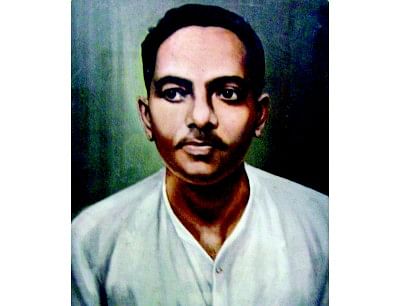Jibanananda's thoughts on death, surrealism and beyond...

The French literary critic and theorist Roland Barthes believes the death of an author makes readers more responsible toward the creations of the author. He concludes his essay, Death of the Author thus: "The birth of the reader must be at the cost of the death of the author." Here judgement or the birth of a reader takes a prominent place. And that comes through observing the place the modern Bengali poet Jibanananda Das for those who love poetry.
The Nobel laureate Bengali poet Rabindranath Tagore termed Das' poems as "Chitraroopmoy" because they capture outstanding images and go for some unparalleled application of similes and metaphors, which in turn subtly portray the ecstasies working on the psyche of poetry connoisseurs. Das's litterateur friend and one among the Panchapandob (five certain poets of Bengali literature, including Jibanananda Das) named him as "Nijontomo Kobi."
Das himself appraised his poetry in this way: "Someone has termed my poetry or the poet of this poetry as silent or most silent; some have said the poems relate predominantly to Nature and resurrect historical and social conscience. Someone has judged the pieces as solely symbolic, completely subconscious and surrealistic. I have also noticed some other explanations of my poems. Almost all the comments are partially true."
Jibanananda Das viewed Poetry and Life as a two-way origination of the same entity. As he noted, "Historical conscience will be the bone of the poem while clear knowledge about time will live in its (poem's) heart."
Das's advent in the world of Bengali poetry was like an egotitistic fallen feather. He boastfully starts his lone essay on poetry, titled 'Kobitar Katha' thus: Shokolei Kobi Noy Keu Keu Kobi (all are not poets but some are).
Das's 'Dhushor Pandulipi' (1936) is thought to be the grey manuscript of his autobiographical sketches. He roams around like an owl on a dewy autumn night and puts his 'silent signature' on a multiplicity of personal feelings
'Dhushor Pandulipi' contains Jibanananda's biggest poem Jibon (34 stanzas) that ends with the line morar kobor chherhe prithibir dikey tai chhute gelo mon.
Women in Jibanananda's poetic perceptions bear the testimony to the unique character of the poet's imagination. His women appear to be beyond touch as they transcend to a higher plane, surpassing all forms of earthly beauty. Several poems --- Banolata Sen (1942), Mohaprithibi (1944), Saat Ti Tarar Timir (1948) and Jibanananda Das-er Shreshtha Kabita (1954) depict both sensuous and sensual aspects of women, their romantic essences, pathos along with a perfect use of similes and metaphors, surrealism and beyond.
The way Banalata Sen shelters an exhausted poet in her bird's nest-like eyes is mesmerising. Contrasting the similes used in Jibanananda's Banolata Sen with those in Edgar Allan Poe's To Helen, one seems to detect the influence of the former on the latter. Das's chul taar kobekar ondhokar bidishar nisha/mukh taar shrabostir karukarjo/ otidur samudrer 'por haal bhengey je nabik harayechhey disha sounds more rhetorical than Poe's Thy hyacinth hair, thy classic face, than a combined outcome of 'the glory that was Greece' and 'the grandeur that was Rome.'
In Banalata Sen we find antique shankhamala and exquisite imagery. Perhaps Jibanananda Das was instinctively moved to create such immaculate imaginary women on account of going through an unhappy conjugal life.
The poem Aat Bochhor Aager Ekdin from Mohaprithibi depicts the poet's eternal pathos that instigates him on to symbolic suicide. We also notice allusions to surrealism in several of Das' poems. We may mention Horinera, Ghora, Buno Haa(n)s, Obosheshey, Shob and Hawar Raat as complete poems that are apparently influenced by the surrealist poetry movement.
The French poets André Breton (1896-1966), Louis Aragon (1897-1982) and others were the forerunners of the surrealist poetic movement. Louis Aragon published "Manifest du Surrealism" in 1924. Prior to that poet Geom Apollonian coined the term "Surrealist" in 1917.
The dictionary defines Surrealism as a movement in 20th century literature and art which attempts to express and exhibit the workings of the subconscious mind, especially as manifested in dreams and uncontrolled by reason and characterised by the incongruous. and startling arrangement and presentation of subject matter."
Jibanananda's birth (18 February 1899) is a more astonishing and important event in the realm of Bengali poetry than his death (22 October 1954) as he delightfully emptied his thoughts on death in almost all the poems of Ruposhi Bangla, poetry that was published after the poet's death.
Initiating the poet's unparalleled love for Bengal's nature, Ruposhi Bangla focuses on soft light from the faraway glittering stars in order to have it enter the Bengali psyche. The poems of Ruposhi Bangla were written very rapidly, one after another. And something of a consciousness of death, mingled with patriotic passion and unfathomable love for idyllic Bengal, has exquisitely portrayed rare allusions in such a way that we might identify the feeling as Romantic agony. A reading of Ruposhi Bangla instinctively persuades a connoisseur of poetry to fervently kiss the lips of death.
Ruposhi Bangla signifies multifaceted expressions of meaning, focuses on multinuclear shades of thoughts. Nature appears livelier and its form seems identical with that of woman in Ruposhi Bangla. The poetry also outlines thoughts on myths and symbols, patriotism and personal love, decaying illness and morbidity and death and memory.
(Jibanananda Das' death anniversary falls today. He died on 22 October 1954).

 For all latest news, follow The Daily Star's Google News channel.
For all latest news, follow The Daily Star's Google News channel. 



Comments